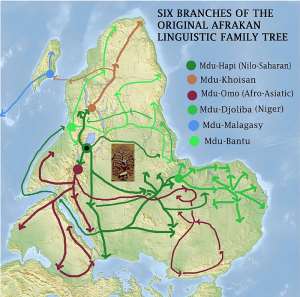
There is only one Afrakan linguistic family tree. However, there are branches within this family.
The earliest is Mdu-Hapi. This originated in Central-East Africa with the dawn of homosapiens. This branch is often mislabeled by Europeans as the "Nilo-Saharan" family. The oldest members include people like the Luo, Maasai, Dinka, Nuer, etc. The ancient Twa language was also Mdu-Hapi, but most Twa people today have adopted the languages of newer Bantu immigrants. Mdu-Hapi languages also spread into the Sahel and Sahara. Sara, Kanuri, and Songhai are all classified as so-called Nilo-Saharan, which is really Mdu-Hapi. Egyptologist Albert Churchward proved over a century ago that both the Kushite and Kemetic languages were of the Mdu-Hapi branch (Nilo-Saharan) of the African linguistic tree. The surviving Nubian language remains Mdu-Hapi.
The Khoisan languages diverged earliest. These were nomadic Twa people who moved south of the equator. They retain some ancient elements of Mdu-Hapi that have changed due to foreign influence in more recent centuries. For example, both Mdu-Hapi and Khoisan contained "click" sounds in ancient times. The Kemetic language was full of these ancient clicks.
The next branch to diverge was the Mdu-Omo branch. It is named so because it developed first in the Omo Valley of southwest Ethiopia. This branch is mislabeled "Afro-Asiatic" by Europoids. However, it was not developed in Asia so there is nothing "Asiatic" about it. This branch is very important historically which is why Europoid linguists have tried so desperately to cloud the nature of this branch by using fake biblical concepts like Semetic and Cushitic. The term "Cushitic" is inappropriate for it because the so-called Cushitic languages are not the same as that of actual Kush (which was Mdu-Hapi/Nilo-Saharan). This biblical misnaming has brought great confusion. The Medu-Ntchr and Meroitic written languages belong to the Mdu-Hapi (Nilo-Saharan) branch, not the so-called Afro-Asiatic branch. Either way, both belong to the African linguistic tree.
The next branch to diverge was the Mdu-Djoliba branch. This branch is mislabeled "Niger" by Europoids. Though named after the river, the word Niger has no origin in West Africa so it is inaccurate. The most widely known indigenous name for that great river is the Manding name "Djoliba." In antiquity (around the time of the expansionist Nok civilization), a significant but small population of Mdu-Djoliba speakers lived in Central Africa
The fifth branch to diverge was the Mdu-Malagasy branch. This branch is unique in that it originated from Khoisan speakers who settled Madagascar; however, the isolation of that great island caused it to develop distinct characteristics in the language and phenotype of the people. While yellow-brown skin, flat noses, full lips, and "slanted" eyes was a trait they brought with them from the Khoisan, it was in the isolation period of Madagascar that they developed a common trait for wavy hair that they would take with them as they settled Southeast Asia's islands. Contrary to Europoid lies, the presence of Malagasy in Madagascar did not come from the South East Asia's islands, but was brought there by people from Madagascar, who are the origin of the Mongoloid features (though Mongoloids developed into a distinct race of their own).
The youngest branch is the Mdu-Bantu branch. This branch is complex in that it is actually a melting pot of earlier branches. This branch originated from Kushite-Kemetic sailors who sought refuge in East Africa's coast due to invasion. However, their new land (Kenya-Tanzania) was already home to other Mdu-Hapi speakers (such as the Maasai and Luo), Khoisan, as well as a considerable amount of Mdu-Djoliba speakers who arrived there during Nok expansionism. The mixture of all of these languages gave birth to the Bantu branch, whose oldest member is Pre-Islamic KiSwahili. The Bantu eventually grew to be the most populous group in East Africa and spread out into Central and Southern Africa.
As you can see, the six branches of the African linguistic Tree reveal the interconnectedness of the African race.
Give thanks to MaTseba.
MaTseba
MoKga-a-Bjwala
Edward Mitole, PhD
Founder & Chair
The African Renaissance Project




 May Day: We’re committed to giving you brighter future – NDC assure workers
May Day: We’re committed to giving you brighter future – NDC assure workers
 Kasoa: Military officer shot dead over land dispute at Millennium City
Kasoa: Military officer shot dead over land dispute at Millennium City
 'It's a digrace for Akufo-Addo gov't' – Aduomi on vote-buying allegations at Eji...
'It's a digrace for Akufo-Addo gov't' – Aduomi on vote-buying allegations at Eji...
 Yagbonwura was never asked to stand and greet President Akufo-Addo – Chieftaincy...
Yagbonwura was never asked to stand and greet President Akufo-Addo – Chieftaincy...
 Ejisu by-election: We must ‘aggressively’ reach out to disgruntled NPP members –...
Ejisu by-election: We must ‘aggressively’ reach out to disgruntled NPP members –...
 Ejisu by-election: I didn’t bribe EC officials – Kwadaso MP
Ejisu by-election: I didn’t bribe EC officials – Kwadaso MP
 NPP’s Kwabena Boateng wins Ejisu by-election 55.8%
NPP’s Kwabena Boateng wins Ejisu by-election 55.8%
 We’ll bring back Aduomi to NPP – Stephen Ntim
We’ll bring back Aduomi to NPP – Stephen Ntim
 Bright Simons writes: How SML confused Ghanaian professors
Bright Simons writes: How SML confused Ghanaian professors
 Ejisu by-election: Provisional results so far
Ejisu by-election: Provisional results so far
